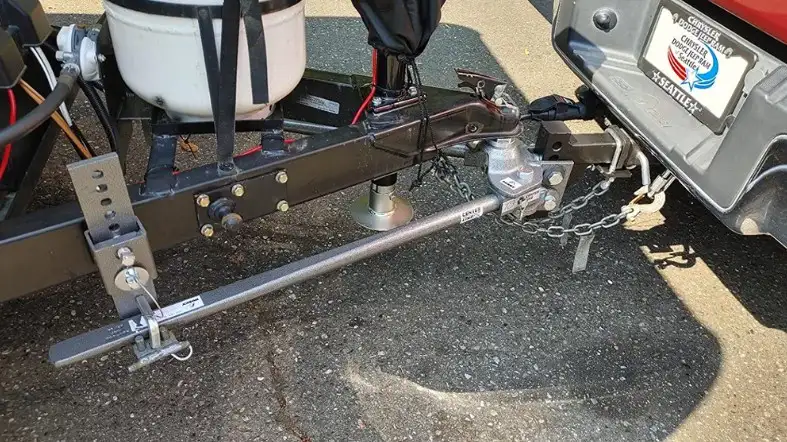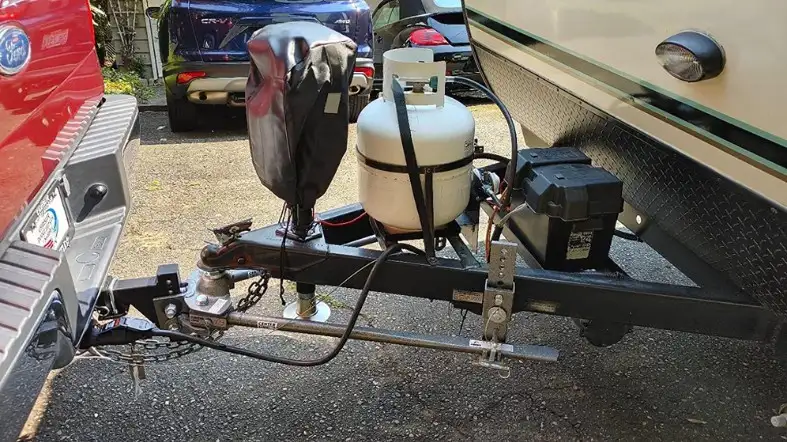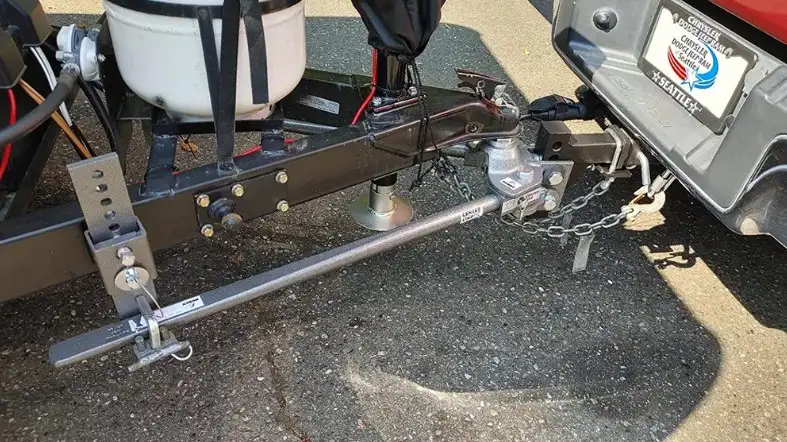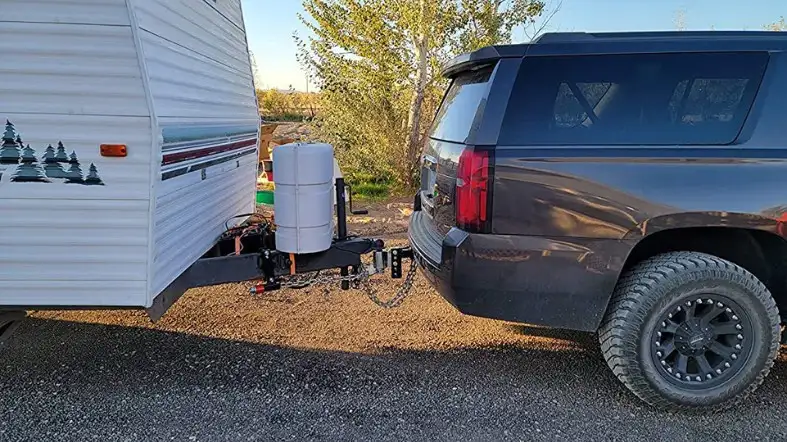If you’re towing a trailer, distributing the load evenly is key to avoiding wrecks and ruining your camping trip.
Weight distribution bars help distribute the weight evenly and installing weight distribution bars is a great way to improve the stability of your tow vehicle and trailer.
This guide will show you how to install weight distribution bars yourself, step by step.
Follow these simple instructions and you’ll be on your way to safer towing in no time!
How To Install Weight Distribution Bars?

Installing weight distribution bars is a relatively simple process that can be completed in a few steps:
Step 1: Choosing the Right Weight Distribution Bars
The first step in choosing the right weight distribution bars for your vehicle is to determine the maximum tongue weight (TW) and gross trailer weight (GTW) of your trailer.
Tongue weight is the amount of weight that is exerted on the hitch by the trailer, and gross trailer weight is the total weight of the trailer and its contents.
Once you know these values, you can choose a set of weight distribution bars that have a maximum capacity that exceeds both the TW and GTW of your trailer.
Step 2: Position the vehicle so that the tongue is level with the ground
The second step is to position the vehicle so that the tongue is level with the ground.
This will ensure that the weight is distributed evenly when the bars are installed.
Step 3: Attach the brackets to the frame of the vehicle
The next step is to attach the brackets to the frame of the vehicle.
This can be done by drilling holes and using bolts or by welding them in place.
Step 4: Attach the chains to the brackets
Once the brackets are in place, the chains can be attached to them.
The chains should be tightened so that there is no slack, but not so tight that they cause damage to the frame or suspension.
Step 5: Adjust as needed
Once everything is in place, it may be necessary to make some adjustments to ensure that the weight is distributed evenly.
This can be done by moving the location of the brackets or by adjusting the tension on the chains
How do Weight Distribution Bars work?
Weight distribution bars, also known as load bars or weight distribution hitches, are an important part of any towing setup.
They are used to distribute the weight of a trailer evenly across the axle of a tow vehicle.

This helps to prevent the trailer from becoming overloaded on one side, which can cause instability and potentially lead to an accident.
Weight distribution bars also help to level out a trailer, which can improve handling and braking performance.
When choosing weight distribution bars, it is important to select a size and style that is compatible with your tow vehicle and trailer.
Larger and heavier trailers will need heavier-duty bars, while smaller trailers can usually get by with lighter-duty bars.
It is also important to make sure that the weight distribution bars are properly secured before heading out on the road.
Tips For Using Weight Distribution Bars Safely

Once you have your weight distribution bars installed, it is important to use them safely on the road.
Here are a few tips for using weight distribution bars safely:
Read the Instructions
The first step in safely using weight distribution bars is to read the instructions that come with them.
This may seem like an obvious step, but it is important to make sure that you understand how the bars work and how to properly install them.
If you have any questions, be sure to contact the manufacturer.
Inspect the Bars Before Use
Before using weight distribution bars, it is important to inspect them for any damage or wear.
This includes checking for cracks, bends, or other damage that could weaken the bars or cause them to fail.
If you find any damage, do not use the bars and contact the manufacturer for replacement parts.
Follow the Weight Limits
When using weight distribution bars, it is important to follow the weight limits that are specified by the manufacturer.
These limits are in place for a reason and exceeding them could result in serious injury or even death.
Use Proper Installation Techniques
When installing weight distribution bars, it is important to use proper installation techniques.
This includes making sure that the bars are properly secured to the vehicle and that all of the bolts and nuts are tightened correctly.
If you are unsure of how to properly install the bars, be sure to consult a professional mechanic.
Inspect the Bars After Use
After using weight distribution bars, it is important to inspect them for any damage or wear.
This includes checking for cracks, bends, or other damage that could weaken the bars or cause them to fail.
If you find any damage, do not use the bars and contact the manufacturer for replacement parts
The Benefits Of Using Weight Distribution Bars

There are many benefits to using weight distribution bars when towing a trailer, including:
Improve towing
The primary benefit of using weight distribution bars is that they improve towing.
Weight distribution bars help to distribute the weight of the trailer evenly across the axle of the tow vehicle, which helps to improve handling and braking.
Additionally, weight distribution bars can help to prevent the trailer from swaying back and forth, which can be dangerous.
Prevent damage
Another benefit of using weight distribution bars is that they can help to prevent damage to the tow vehicle and trailer.
When the weight of the trailer is not evenly distributed, it can put undue stress on the hitch, tires, and suspension of the tow vehicle.
This can lead to premature wear and tear, and in some cases, can even cause accidents.
Improve gas mileage
Another benefit of using weight distribution bars is that they can help to improve gas mileage.
When the weight of the trailer is not evenly distributed, it can cause the tow vehicle to work harder, which will use more fuel.
By distributing the weight evenly, weight distribution bars can help to improve gas mileage by up to 10%.
Increase safety
Weight distribution bars also help to increase safety by improving visibility.
When the weight of the trailer is not evenly distributed, it can block the view of the driver’s mirrors.
This can make it difficult to see other vehicles or obstacles on the road, which can increase the risk of accidents.
By distributing the weight evenly, weight distribution bars can help to improve visibility and increase safety on the road.
What Happens If I Do Not Use Weight Distribution Bars When Towing?
If you do not use weight distribution bars when towing, there is an increased risk of damage to your trailer and tow vehicle.
This can include things like premature wear of the tires or suspension, damage to the hitch, and even accidents due to poor handling or visibility.
FAQs on how to install weight distribution bars
How Tight Should Weight Distribution Bars Be?
There is no set rule for how tightly you should tension your weight distribution bars.
Factors like the load on your trailer, the type of terrain you are driving on, and your vehicle’s suspension may all influence how tight you need to adjust your bars.
As a general rule, though, it is best to tighten the spring arms on your weight distribution bars as tightly as they will go without causing them to buckle.
How Can I Determine If My Weight Distribution Bars Need To Be Adjusted?
There are a few different ways that you can determine if your weight distribution bars need to be adjusted.
One way is to look for signs of wear or damage, such as cracks, bends, or loose bolts.
You can also check the tension on your spring arms and see if they seem too loose or tight.
What is the purpose of weight distribution bars?
Weight distribution bars are used to distribute the weight of a trailer across the tow vehicle and trailer axles, which helps to improve the stability and handling of the vehicle while towing.
They are typically used when towing a heavy trailer, such as a travel trailer or fifth-wheel trailer.
Final Words
Now that you know how to install weight distribution bars, it’s time to get shopping! We hope our comprehensive guide has helped make the process a little less daunting.
Remember to consider your vehicle and trailer specifications when making your purchase, and be sure to ask plenty of questions before you buy.
With the right equipment in tow, hitting the open road is now within reach. Safe travels!
